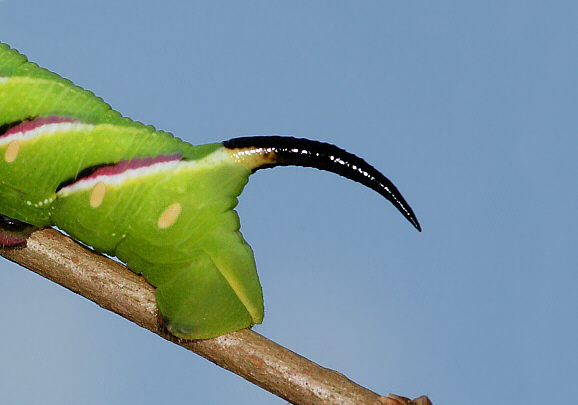 horn on tail of Privet Hawkmoth caterpillar Sphinx ligustri – Adrian Hoskins
horn on tail of Privet Hawkmoth caterpillar Sphinx ligustri – Adrian Hoskins
All Hawkmoths ( Sphingidae ) throughout the world have caterpillars that are equipped with a horn at the tail end. In some species it is short and may be curled like a pig’s tail, while in others it can be extremely long – almost as long as the caterpillar itself !
These horns look sharp and dangerous but are in fact quite soft to touch. They cannot sting and are entirely harmless. The purpose of the horns is apparently unknown and would make a fascinating subject for a scientific study.
Are any caterpillars dangerous to touch ?
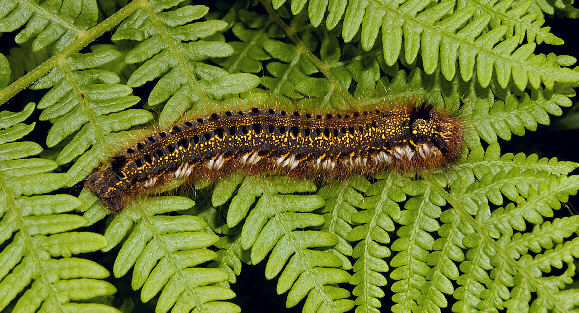
Drinker moth larva Euthrix potatoria – its hairs cause mild itching – Adrian Hoskins
There are over half a million species of caterpillar in the world, and most are completely harmless to touch. Some however, particularly those in the families Megalopygidae, Saturniidae, Lymantridae and Lasiocampidae have hairs or spines which can irritate or sting.
In Europe the most well known example the Brown-tail moth Euproctis chrysorrhoea. The larval webs of this moth are commonly found on hawthorn and bramble, particularly in coastal areas of southern England. The caterpillars shed their hairs easily, and if these become airborne and find their way into human eyes they can cause painful inflammation.
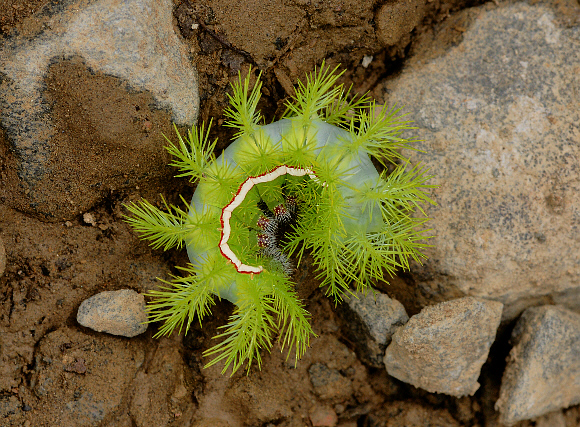 Automeris liberia ( Saturniidae ), Peru – its spines can deliver a painful sting – Adrian Hoskins
Automeris liberia ( Saturniidae ), Peru – its spines can deliver a painful sting – Adrian Hoskins
There are also many species of Saturniidae e.g. Automeris liberia whose caterpillars are adorned with dozens of stinging spines, each shaped like a miniature Xmas tree. In most cases the sting is no worse than that of a nettle plant, but in at least one species it can be lethal :The well camouflaged spiked caterpillars of Lonomia obliqua are often found clustered in groups of up to 100 on the trunks of trees in Amazonia.
There have been many incidents where people have unwittingly touched or rubbed their arm against groups of these caterpillars that were gathered on tree trunks. The effects of a dose from multiple caterpillars can be very severe, including massive intercranial haemorrhaging and kidney failure. Lonomia obliqua caterpillars are a frequent cause of death in southern Brazil – 354 people died between 1989 and 2005. The fatality rate is about 1.7% – roughly equivalent to that of rattlesnake bites. If in doubt keep well away from spiky caterpillars!
Do some moths have feathers instead of wings ?
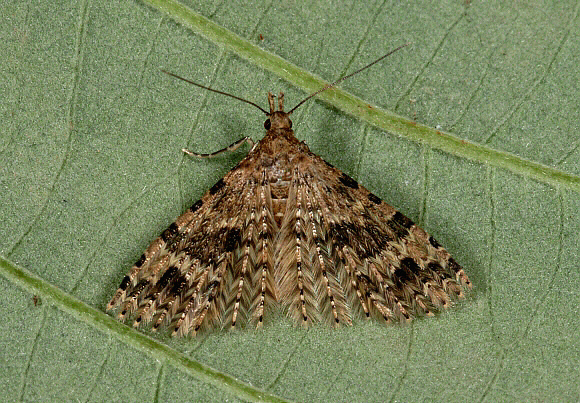 Many-plumed moth Alucita hexadactyla – Adrian Hoskins
Many-plumed moth Alucita hexadactyla – Adrian Hoskins
In a manner of speaking, yes. Most moths have 2 pairs of overlapping wings, each comprised of a very thin double membrane with rigidity supplied by a network of tubular veins that radiate from the base of the wings. The Plume moths ( Pterophorinae ) and Many-plumed moths ( Alucitidae ) however have no wing membranes. Instead their fore and hind wings each consist of feathery plumes – rigid spines from which branch dozens of long thin plume-like scales.
There are 186 known species of Alucitidae worldwide, many of which have only been discovered in the last 20 years. The name of the moth illustrated above, hexadactyla translates as ’20 fingers’ and is a misnomer as the moth actually has 24 ‘feathers’, although some are hidden from view.
Which layer of the rainforest do butterflies live in ?
Butterflies live at all layers in the rainforest. Some species never fly more than about a foot above the ground. Others live permanently at the top of the tallest trees. A myriad of other species live in the various layers in between. There are also many species which normally live in the tree tops but sometimes come down to ground level at “light gaps” where sunlight penetrates to the forest floor.
Why do male butterflies emerge before females ?
In species which overwinter as adults, e.g. the Brimstone, it is noticeable that males awaken from hibernation about 2 or 3 weeks before the first females appear. The probable reason is that prior to copulation the females are very sedentary – it would be wasteful for them to fly until after they have mated, and would expose them to the risk of predation unnecessarily. Males on the other hand need a few days beforehand to feed up on flower nectar and build up their food reserves, giving them the energy to enable them to fly all day in search of potential mates.
In species that emerge from the chrysalis in spring and summer, e.g. the Swallowtail, the males emerge on average about a week before the females. The reason for this is that females lose their attraction to males very quickly, probably because the strength of their pheromones diminishes with passing time. Consequently they must mate within a day or two of emergence, so nature ensures that there are plenty of males already available for the females when they emerge.
Why do butterflies gather at sandbanks and mud ?
Butterflies seen on sandbanks or imbibing moisture from muddy patches are almost always males. They home in on sources of sodium and nitrates which are found dissolved in mud or damp sand. This process is commonly called ‘mud-puddling’. Sodium is vital for physiological functions including digestion, reproduction and flight.
Urine-soaked ground, carnivore dung and bird droppings are especially rich in these minerals, and can attract large aggregations of males. Males usually mate with more than one female, so after mating they need to puddle again to replenish lost salts. Typically just one or two males will chance upon a suitable feeding spot, but other butterflies flying past seem able to recognise their brethren on the ground, and swoop down to join them.
The bright patch of colourful butterflies quickly becomes a magnet to every passing male of the same species. Females do not normally ‘mud-puddle’, they feed instead on nectar, fallen fruit and other organic matter. They obtain their sodium in a different way. It is passed to them along with spermatophore, by the males during copulation. Females therefore do not need to waste valuable time puddling, and can instead concentrate on searching for good oviposition sites.
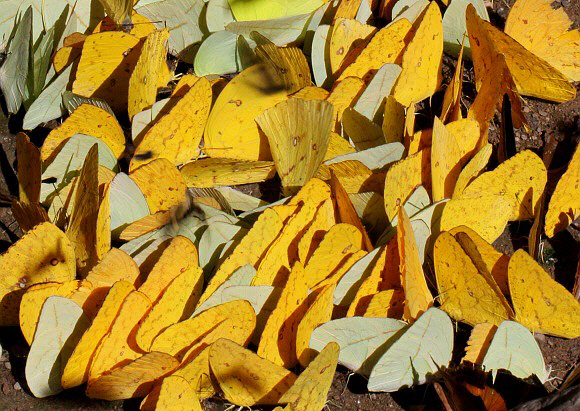 Phoebis argante and Rhabdodryas trite. Males aggregating at Satipo, Peru – Adrian Hoskins
Phoebis argante and Rhabdodryas trite. Males aggregating at Satipo, Peru – Adrian Hoskins
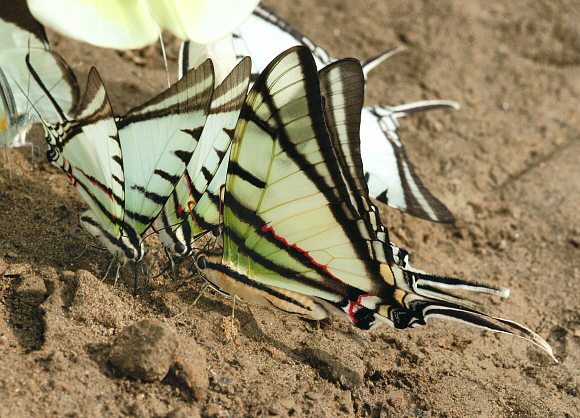 Protesilaus earis, Madre de Dios, Peru – Adrian Hoskins
Protesilaus earis, Madre de Dios, Peru – Adrian Hoskins
How long ago did butterflies evolve ?
Estimates of the age of the earliest insect fossils date back to at least 300 million years ago ( MYA ). The earliest Lepidoptera ( butterflies, moths and skippers ) are generally supposed to have evolved from the Trichoptera ( caddis flies ) somewhere in the region of 140-200 MYA, at roughly the same time as the appearance of the first flowering plants. At one time, the land masses of the Earth were divided into 4 continents – Laurentia, Baltica, Siberia and Gondwanaland. They gradually converged, and about 350 MYA became linked to form the super-continent Pangaea. Butterflies and other insects probably originated on Pangaea, which then began to break up about 130 MYA, ultimately forming the present day continents.
The species which first appeared on Pangaea have long been extinct, but nevertheless many of the genera and species flying today have been in existence for millions of years – the South American genus Brassolis for example first evolved in the late Eocene Period, about 40 million years ago.
More information on this subject can be found in the Evolution section.
How high can butterflies fly ?
The highest flying butterfly known is the Satyrine Paralasa nepalica, discovered by PAULUS in 1983. The butterfly is found at altitudes as high as 4500m ( 14800 ft ) in Shey Phoksundo national park in Nepal. Another butterfly, the Uncompahgre Fritillary Boloria improba acrocnema, spends its entire lifecycle at altitudes between 4000-4200m in the San Juan mountains of Colorado, USA, although other subspecies breed at lower altitudes in Canada. Perhaps even more amazing however is the Painted Lady Vanessa cardui which is found in almost every region of the world in habitats ranging from deserts to rainforests, prairies and tundra, and has been recorded at altitudes between sea level and 4000m !
What are frass-chains ?
The theory is that it is a defence strategy to protect tiny larvae from marauding ants observations by Phil DeVries for example indicate that ants are unwilling to walk out on the ‘tight-rope’ to attack larvae. This may be because they cannot grip it properly to walk on, or possibly because the frass contains a toxin that deters them. The latter might also explain why larvae of many micro moths camouflage themselves with their droppings, rather than decorating themselves with fragments of leaves.
Where did the Purple Emperor’s name originate ?
In the British colonial era butterfly collecting was a popular Pastime for army officers, who invented English names for their captures. It became traditional to name insects after army or naval ranks or sovereign titles. Hence there are moths such as the Golden Emperor, and butterflies including the Archduke, Monarch, Commodore, Black Prince, Commander, Chocolate Soldier, Baron, Palm King, Lance Sergeant, Tawny Rajah and Queen Alexandra Birdwing.
The Purple Emperor butterfly however was named by Moses Harris in 1766. The reason for its name was probably simply a reference to it’s magnificence – it is one of the largest and most highly prized butterflies in Europe. The name could also be connected to the fact that the male Purple Emperors habitually perch on clumps of leaves, known commonly as “thrones” at the top of high oak trees. They use these perches as lookout posts from which to sight and intercept females. It is common to see groups of males engaged in aerial dog-fights, competing for the best “throne” position.
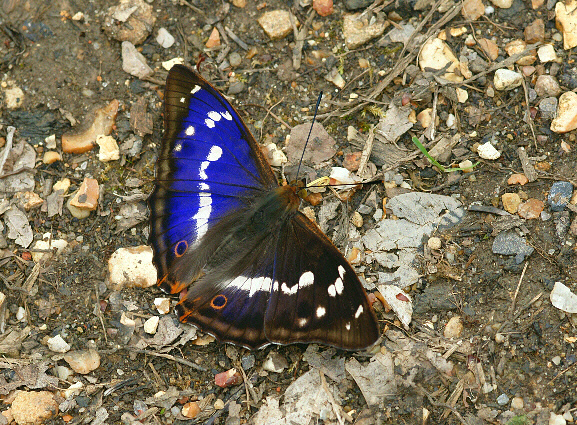 Purple Emperor Apatura iris, male, Hampshire, England – Adrian Hoskins
Purple Emperor Apatura iris, male, Hampshire, England – Adrian Hoskins
Why do some butterflies have hairy eyes ?
All butterflies in the genus Lethe ( Satyrinae ) have a dense layer of fine bristles or ‘hairs’ on their compound eyes. My observations of various Lethe species in Sri Lanka, Borneo and West Malaysia indicate that the adults are strongly attracted to wet dung and spend long periods probing into it, at which times their heads push right into the substance. It seems possible therefore that the ‘hairs’ may function in the same way as a cat’s whiskers, acting as tactile sensors which warn the butterfly if their eyes get too close to the dung, which would almost certainly blind them if it adhered to the surface of the eyes.
Bear in mind however that not everything in nature has a purpose or reason. It could simply be the case that the hairs first appeared as a random mutation that was neither beneficial or harmful, and consequently there would be no natural selection pressure for it to ‘breed out’ and revert to a non-hairy eye.
Frass chains are constructed by many caterpillars, chiefly neotropical and Afro-Asian Nymphalidae. When not feeding, the young larvae rest at the tip of a chain constructed from their own droppings. The larva typically eats away the leaf tissue, leaving only the midrib intact, and then deposits a row of its droppings along the midrib. The droppings are bound together with silk. The line or ‘chain’ of droppings ( frass ) is then extended so it projects by about 2 centimetres beyond the leaf tip.
